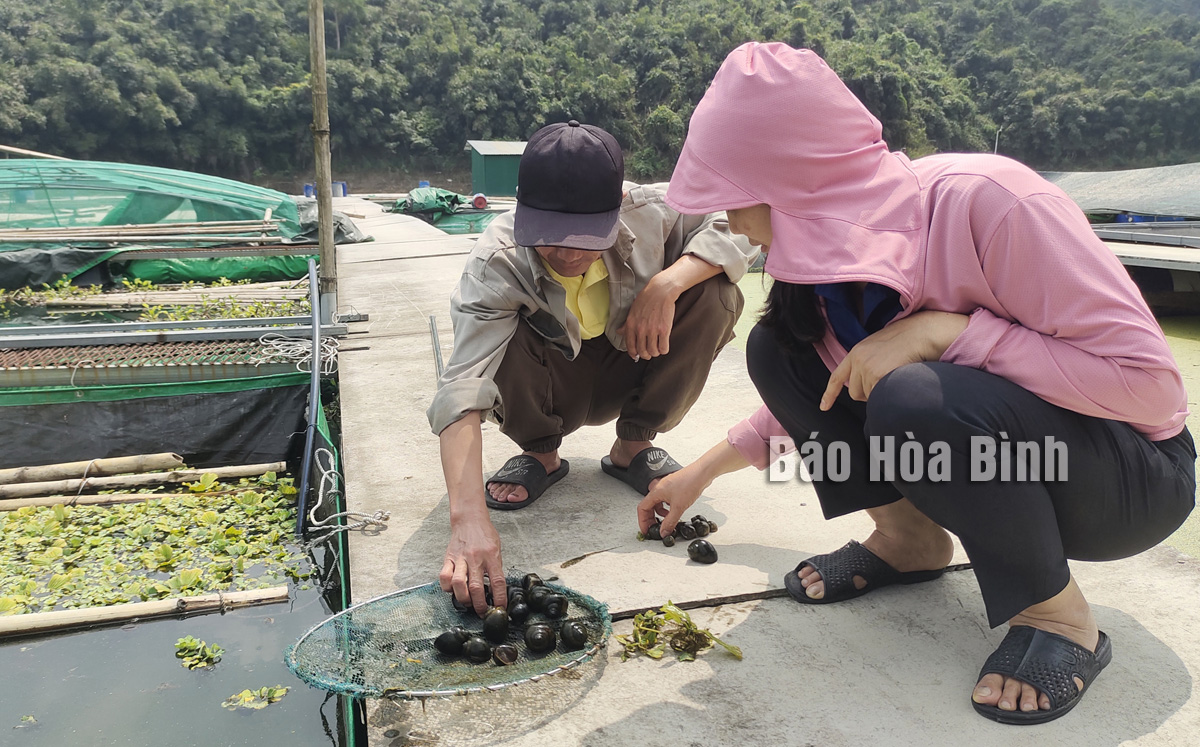
Aquatic species with high economic values have been raised in Hoa Binh lake, along with traditional ones, expected to meet market needs.
An edible snail farming model in Hoa Binh lake.
The Thien Phu Ngu Cooperative in Trang hamlet, Binh Thanh commune, Cao Phong district, started raising edible snails (pila conica) in 2023. So far, it has had 20 cages for commercial pila conica faming.
The cooperative also has a snail egg hatchery, so it not only has a stable breeding supply but also provides small snails for the market.
According to the cooperative's representative, with a suitable environment, the snails grow well. Each kilo of the edible snails can be sold at 150,000 VND (6 USD).
The cooperative is also planning to pilot to shrimp raising in cages which is a promising direction of the local agricultural development.
Meanwhile, seeing huge demand for spiny loach - one of the specialty fish species in Hoa Binh lake, Tran Hung Cuong – a local resident in Thai Binh ward, Hoa Binh city came up with the idea of raising the fish in cages in 2019.
Cuong travelled to the southern province of Long An to learn how to raise the fish in lagoons and lakes. With a suitable farming environment and determination, Cuong's spiny loach raising model has been proved effective and applied by other households.
Dang Thi Duyen, Deputy Director of the provincial Department of Fisheries, said that in the last few years, people have diversified species, especially raising some specialty fish species with high economic value such as spiny loach, Hemibagrus microphthalmus, barbel fish, sturgeon and pila conica.
In 2024, the department will launch a model to test raising Barramundi in communes of Son Thuy (Mai Chau district), Tien Phong (Da Bac district) and Thai Binh ward (Hoa Binh city).
According to statistics of authorities, there are 5,000 fish cages in Hoa Binh lake, bringing income to about 2,000 households.
In addition to promote production, consumption, and brand building, the province focuses on diversifying farming species to create valuable Da River fish products to ensure sustainable fishery development and increase incomes to people in the Hoa Binh lake area.
Hoa Binh province is undergoing a dynamic transformation amid Vietnam’s national digital transition. Building on Poliburo’s Resolution No. 57-NQ/TW on breakthroughs in science, technology, innovation, and national digital transformation, the province has rolled out a wide range of practical action plans. A standout initiative is the "Digital Literacy for All” movement, an effort to ensure that no one is left behind in the digital era.
Hoa Binh province is undergoing a dynamic transformation in the wake of the national digital transformation movement. Building on Resolution No. 57-NQ/TW of the Politburo on breakthroughs in science, technology, innovation, and national digital transformation, the province has implemented a wide range of practical action plans. A standout initiative is the "Digital Literacy for All” movement ambitious effort to ensure that no one is left behind in the digital age.
With a spirit of unity and proactive problem-solving, the Party Committee, the government and the people of Dong Lai Commune (Tan Lac District) have made great strides in implementing the resolutions of the 24th Party Congress of the commune for the 2020 - 2025 term. Focusing on leadership and practical actions, the commune has brought the Party’s resolutions into daily life, creating strong impacts and pushing the local development forward.
Amid the nationwide push for digital transformation, young people in Hoa Binh Province are stepping up as dynamic pioneers, applying technology to enhance Youth Union operations and expand the reach of youth-led initiatives. Through creativity and adaptability, Youth Union organizations at all levels have introduced a series of practical solutions, contributing to modern governance and community development.
In recent years, An Nghia commune, located in Lac Son district, has stepped up administrative reform, focusing on improving the quality and efficiency of its single-window service unit for receiving and processing administrative procedures. These improvements have helped create favourable conditions for local residents and organisations to handle administrative procedures, contributing to the commune’s broader socio-economic development.
The Prime Minister-approved master plan to develop the multi-use value of forests ecosystems through 2030, with a vision to 2050, aims to improve the management and sustainable use of forest resources, create jobs, increase incomes, and improve the living standards of ethnic minorities, people in mountainous and remote areas, forest workers and those living near forests.



